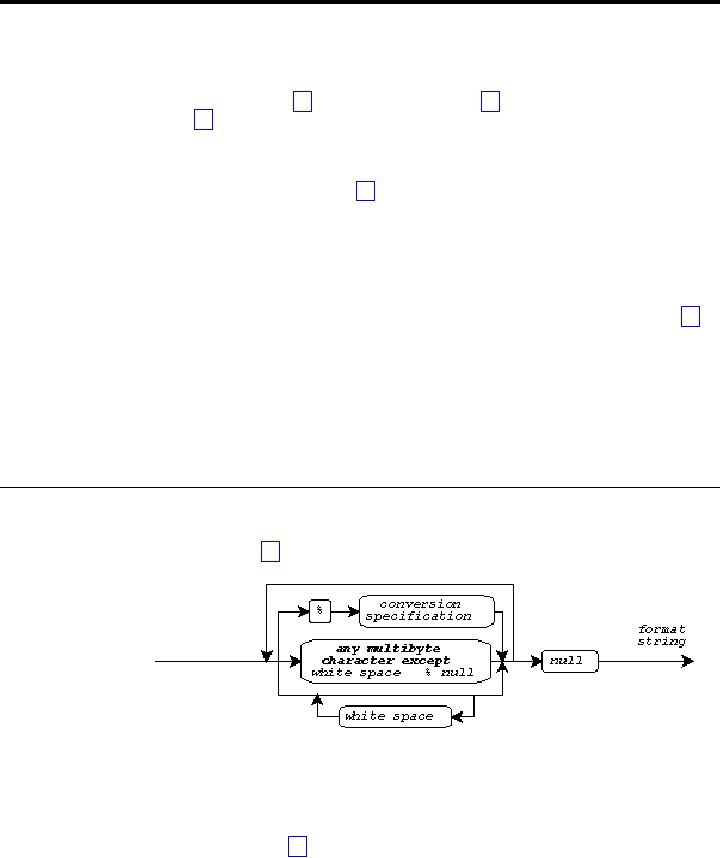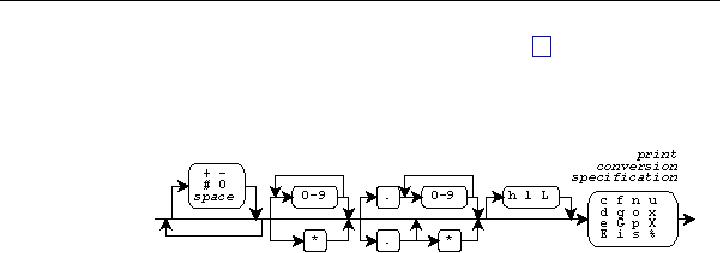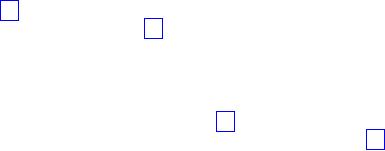 |

Chapter
8. Formatted Output
(page 33)
Several
library functions help you
convert data values from
encoded internal
representations
to text sequences that are
generally readable by people.
You
provide
a format string (page 31)
as the value of the format
argument
to each of
these
functions, hence the term
formatted
output. The
functions fall into
two
categories.
The
byte
print functions (declared
in <stdio.h>) convert internal
representations to
sequences
of type char,
and
help you compose such
sequences for display: fprintf,
printf, sprintf, vfprintf, vprintf, and vsprintf. For
these function, a
format
string
is a multibyte string that
begins and ends in the
initial shift state (page 12).
The
wide
print functions (declared
in <wchar.h> and hence added
with
Amendment
1)
convert internal representations to
sequences of type wchar_t,
and
help
you compose such sequences for
display: fwprintf, swprintf, wprintf,
vfwprintf, vswprintf, and vwprintf. For
these functions, a format
string is a
wide-character
string. In the descriptions
that follow, a wide character
wc
from
a
format
string or a stream is compared to a
specific (byte) character c as if
by
evaluating
the expression wctob(wc)
== c.
Print
Formats
A
format
string has
the same syntax for both
the print functions and the
scan
functions
(page 25),
as shown in the
diagram.
A
format string consists of
zero or more conversion
specifications interspersed
with
literal text and white
space. White
space is a sequence of one or
more
characters
c
for
which the call isspace(c)
returns
nonzero. (The characters
defined
as
white space can change when
you change the LC_CTYPE
locale category.) For
the
print functions, a conversion
specification is one of the
print conversion
specifications
(page 32)
described below.
A
print function scans the
format string once from
beginning to end to
determine
what
conversions to perform. Every
print function accepts a
varying number of
arguments,
either directly or under
control of an argument of type
va_list. Some
print
conversion specifications in the
format string use the
next argument in the
list.
A print function uses each
successive argument no more
than once. Trailing
arguments
can be left unused.
31

In
the description that
follows:
v
integer
conversions are
the conversion
specifiers that
end in d, i, o, u, x, or X
v
floating-point
conversions are
the conversion specifiers
that end in e, E, f, g,
or
G
Print
Functions
For
the print functions, literal
text or white space (page 31)
in a format string
generates
characters that match the
characters in the format
string. A print
conversion
specification typically
generates characters by converting
the next
argument
value to a corresponding text
sequence. A print conversion
specification
has
the format:
Following
the percent character
(%) in the
format string, you can write
zero or
more
format
flags:
v
-
-- to
left-justify a conversion
v
+
-- to
generate a plus sign for
signed values that are
positive
v
space
-- to
generate a space
for
signed values that have
neither a plus nor a
minus
sign
v
#
-- to
prefix 0
on an
o
conversion,
to prefix 0x
on an
x
conversion,
to prefix 0X
on
an X
conversion,
or to generate a decimal point and
fraction digits that
are
otherwise
suppressed on a floating-point
conversion
v
0
-- to pad a
conversion with leading zeros
after any sign or prefix, in
the
absence
of a minus (-) format
flag or a specified
precision
Following
any format flags, you can
write a field
width that
specifies the
minimum
number of characters to generate for
the conversion. Unless
altered by a
format
flag, the default behavior
is to pad a short conversion on the
left with space
characters.
If you write an asterisk (*)
instead of a decimal number for a
field
width,
then a print function takes
the value of the next
argument (which must
be
of
type int)
as the field width. If the
argument value is negative, it
supplies a -
format
flag and its magnitude is
the field width.
Following
any field width, you can
write a dot (.)
followed by a precision
that
specifies
one of the following: the
minimum number of digits to generate on
an
integer
conversion; the number of
fraction digits to generate on an
e, E, or f
conversion;
the maximum number of
significant digits to generate on a
g
or
G
conversion;
or the maximum number of
characters to generate from a C string
on
an
s
conversion.
If
you write an *
instead
of a decimal number for a precision, a
print function
takes
the value of the next
argument (which must be of
type int)
as the precision.
If
the argument value is
negative, the default
precision applies. If you do not
write
either
an *
or a
decimal number following the
dot, the precision is
zero.
32
Standard
C++ Library

Print
Conversion Specifiers
Following
any precision (page 32),
you must write a one-character
print
conversion
specifier,
possibly preceded by a one-character
qualifier. Each
combination
determines the type required
of the next argument (if
any) and how
the
library functions alter the
argument value before
converting it to a text
determine
what base to use for the
text representation. If a conversion
specifier
requires
a precision p
and
you do not provide one in
the format, then
the
conversion
specifier chooses a default
value for the precision. The
following table
lists
all defined combinations and
their properties.
Conversion
Argument
Converted
Default
Pre-
Specifier
Type
Value
Base
cision
%c
int
x
(unsigned
char)x
%lc
wint_t
x
wchar_t
a[2] = {x}
%d
int
x
(int)x
10
1
%hd
int
x
(short)x
10
1
%ld
long
x
(long)x
10
1
%e
double
x
(double)x
10
6
%Le
long
double
x
(long
double)x
10
6
%E
double
x
(double)x
10
6
%LE
long
double
x
(long
double)x
10
6
%f
double
x
(double)x
10
6
%Lf
long
double
x
(long
double)x
10
6
%g
double
x
(double)x
10
6
%Lg
long
double
x
(long
double)x
10
6
%G
double
x
(double)x
10
6
%LG
long
double
x
(long
double)x
10
6
%i
int
x
(int)x
10
1
%hi
int
x
(short)x
10
1
%li
long
x
(long)x
10
1
%n
int
*x
%hn
short
*x
%ln
long
*x
%o
int
x
(unsigned
int)x
8
1
%ho
int
x
(unsigned
short)x
8
1
%lo
long
x
(unsigned
long)x
8
1
%p
void
*x
(void
*)x
%s
char
x[]
x[0]...
large
%ls
wchar_t
x[]
x[0]...
large
%u
int
x
(unsigned
int)x
10
1
%hu
int
x
(unsigned
short)x
10
1
%lu
long
x
(unsigned
long)x
10
1
%x
int
x
(unsigned
int)x
16
1
%hx
int
x
(unsigned
short)x
16
1
%lx
long
x
(unsigned
long)x
16
1
%X
int
x
(unsigned
int)x
16
1
%hX
int
x
(unsigned
short)x
16
1
%lX
long
x
(unsigned
long)x
16
1
%%
none
'%'
The
print conversion specifier
determines any behavior not
summarized in this
table.
In the following descriptions,
p
is
the precision. Examples follow
each of the
print
conversion specifiers. A single
conversion can generate up to
509 characters.
You
write %c
to
generate a single character from
the converted value.
printf("%c",
'a')
generates
a
printf("<%3c|%-3c>",
'a', 'b') generates
<
a|b
>
For
a wide stream (page 18),
conversion of the character
x
occurs
as if by calling
btowc(x).
wprintf(L"%c",
'a')
generates
btowc(a)
33
Chapter
8. Formatted Output
You
write %lc
to
generate a single character from
the converted value.
Conversion
of
the character x
occurs
as if it is followed by a null character in an
array of two
elements
of type wchar_t converted by
the conversion specification ls
(page 35).
printf("%lc",
L'a')
generates
a
wprintf(L"lc",
L'a')
generates
L'a'
You
write %d,
%i,
%o,
%u,
%x,
or %X
to
generate a possibly signed
integer
representation.
%d
or
%i
specifies
signed decimal representation,
%o
unsigned
octal,
%u
unsigned
decimal, %x
unsigned
hexadecimal using the digits
0-9
and
a-f,
and
%X
unsigned
hexadecimal using the digits
0-9
and
A-F. The
conversion generates at
least
p
digits
to represent the converted
value. If p
is
zero, a converted value
of
zero
generates no digits.
printf("%d
%o %x", 31, 31, 31)
generates
31 37 1f
printf("%hu",
0xffff)
generates
65535
printf("%#X
%+d", 31, 31)
generates
0X1F +31
You
write %e
or
%E to
generate a signed fractional
representation with an
exponent.
The generated text takes
the form �d.dddE�dd,
where �
is
either a plus
or
minus sign, d
is
a decimal digit, the dot
(.)
is the decimal point for the
current
locale,
and E
is
either e
(for
%e
conversion)
or E
(for
%E
conversion).
The generated
text
has one integer digit, a
decimal point if p
is
nonzero or if you specify the
#
format
flag, p
fraction
digits, and at least two exponent
digits. The result is
rounded.
The value zero has a
zero exponent.
printf("%e",
31.4)
generates
3.140000e+01
printf("%.2E",
31.4)
generates
3.14E+01
You
write %f
to
generate a signed fractional
representation with no exponent.
The
generated
text takes the form
�d.ddd,
where �
is
either a plus or minus sign,
d
is
a
decimal
digit, and the dot
(.)
is the decimal point for the
current locale. The
generated
text has at least one
integer digit, a decimal
point if p
is
nonzero or if
you
specify the #
format
flag, and p
fraction
digits. The result is
rounded.
printf("%f",
31.4)
generates
31.400000
printf("%.0f
%#.0f", 31.0, 31.0)generates
31 31.
You
write %g
or
%G to
generate a signed fractional
representation with or without
an
exponent, as appropriate. For
%g
conversion,
the generated text takes
the same
form
as either %e
or
%f
conversion.
For %G
conversion,
it takes the same form
as
either
%E
or
%f
conversion.
The precision p
specifies
the number of significant
digits
generated.
(If p
is
zero, it is changed to 1.) If
%e
conversion
would yield an
exponent
in the range [-4, p),
then %f
conversion
occurs instead. The
generated text
has
no trailing zeros in any
fraction and has a decimal
point only if there
are
nonzero
fraction digits, unless you
specify the #
format
flag.
printf("%.6g",
31.4)
generates
31.4
printf("%.1g",
31.4)
generates
3.14e+01
You
write %n
to
store the number of
characters generated (up to this
point in the
format)
in the object of type
int
whose
address is the value of the
next successive
argument.
printf("abc%n",
&x)
stores
3
You
write %p
to
generate an external representation of a
pointer
to void. The
conversion
is implementation defined.
printf("%p",
(void *)&x)
generates,
e.g. F4C0
You
write %s
to
generate a sequence of characters from
the values stored in
the
argument
C string.
34
Standard
C++ Library

printf("%s",
"hello")
generates
hello
printf("%.2s",
"hello")
generates
he
For
a wide stream (page 18),
conversion occurs as if by repeatedly
calling mbrtowc,
beginning
in the initial conversion
state (page 12).
The conversion generates
no
more
than p
characters,
up to but not including the
terminating null character.
wprintf(L"%s",
"hello")
generates
hello
You
write %ls
to
generate a sequence of characters from
the values stored in
the
argument
wide-character string. For a
byte stream (page 18),
conversion occurs as
if
by repeatedly calling wcrtomb,
beginning in the initial
conversion state (page 12),
so
long as complete multibyte
characters can be generated.
The conversion
generates
no more than p
characters,
up to but not including the
terminating null
character.
printf("%ls",
L"hello")
generates
hello
wprintf(L"%.2s",
L"hello")
generates
he
You
write %%
to
generate the percent
character (%).
printf("%%")
generates
%
35
Chapter
8. Formatted Output
36
Standard
C++ Library
Table of Contents:
- C++ Library
- C++ Library Overview:Using C++ Library Headers, Iostreams Conventions
- Characters:Escape Sequences, Multibyte Characters, Wide-Character Encoding
- Expressions
- Files and Streams:Text and Binary Streams, Controlling Streams, Stream States
- Indefinite Integrals of Logarithmic Functions:Combinations of Logarithms and Polynomials, The Logarithm
- Formatted Input:Scan Formats, Scan Functions, Scan Conversion Specifiers
- Formatted Output:Print Formats, Print Functions, Print Conversion Specifiers
- STL Conventions:Iterator Conventions, Algorithm Conventions
- Containers:Cont::const_reference, difference_type, reverse_iterator
- Preprocessing
- Standard C++ Library Header Files:bitset, conj, cos, showpoint, streampos
- Standard Template Library C++:adjacent_find, copy_backward, lexicographical_compare
- Appendix. Type Traits:Helper Class, Primary Type Categories, Binary Type Traits
- Notices:References, Bug Reports